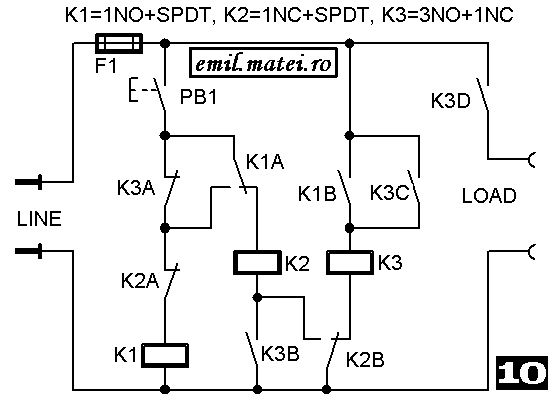
On-Off switch using 3 relays – Fifteen versions !
Since the electrical standards adopted by various nations may vary, the graphical schematic/wiring diagram simbols can also vary (example: DIN, NEMA, IEC, EEMAC, CENELEC). This article uses International/British graphical simbols. For unambiguity, the used simbols are described in the following table:
Several pushbuttons can be wired in parallel to control the the load from multiple locations; the only two wires requires to interconnecting.
Any number of momentary push buttons may be connected in parallelAnother object of the present arrangement is to enable implementation of a motor control circuit by wich a plurality of operators can independently starts and stop the motor by momentary actuation of a pushbutton.
Version 1
The first presented schematic using a traditional relays, is a very interesting Java applet from University of Hamburg. This applet suggestivelly demonstrates how a toggle-flipflop built from 3 relays works:
Link nefunctional (03.03.2013): https://tams-www.informatik.uni-hamburg.de/applets/hades/webdemos/05-switched/20-relays/flipflop3.html
Starting from mentioned schematic, a little modifications comes to following arrangement:

 Only relay d3 needs to have switch contacts rated to the load current, switches on the others are only carrying the relay coil currents.
Only relay d3 needs to have switch contacts rated to the load current, switches on the others are only carrying the relay coil currents.Version 2
Replacement of d2 with a SPDT relay in the previous schematic, comes to alernate version, more advantageous. Some modifications are operated to make posible this upgrade. The following arrangement results:

Version 3
Starting from previous schematic, some modifications are operated to reduce the number of relay’s contacts used (a minimizing is desired to simplify the circuit). This version consist in substitute DPDT relay d1 to SPDT relay. Becouse DPDT=2xSPDT result a simplifed job. The modifications comes to the following arrangement:

Version 4
Trying to optimize the previous version, now, relay d2 having two separate contacts, one normally-open and one normally closed, was subtituted to SPDT relay, modifiyng the schematic so that the function is conserved. So, 4-th version use two SPDT relays (d1 & d2), and a 3xNO relay (d3), like in the following arrangement:

Version 5
This version is a solution posted by roger-k at diyAudio forums. It uses three relays, two with (at least) 3-pole change-over switches and the third with 4-pole c/o switches. Only the third needs to have switch contacts rated to the load current, switches on the others are only carrying the relay coil currents.
He is using the system to power his audio amplifier. An important advantage is pointed by the author: There is no voltage on the electronics when the amp is turned off. (Note: All the present vesions have this advantage).
The schematic is following:

When the button PB1 is first pressed to ON, relay K1 coil is activated through the normally-closed contacts K3A and K2A. Activating of K1 closes normally-open K1C, activating relay K3. Contacts K3A opens, but K1A in parallel has closed taking over from it, keeping K1 energized.
In the meantime, K3B has closed for future use but K1B opened preventing relay K2 from activating.
In the meantime, K3C has closed taking over from K1C and latching the relay K3 coil on.
In the meantime, K3D has closed, so providing a path to the load.Step2:
Releasing the button, relay K1 coil is deactivated, its switches return to the initial state, K2 is also deactivated because PB1 is open, but relay K3 remains on, by reason of self-feeding through K3C.
 Step3:
Step3:When the button PB1 is second pressed to OFF, current flows through K3B and K1B, activating relay K2. The effects of relay K2 activating are breaking K2C nd releasing the latch on relay K3.Step4:is with everything off. All returns to the ‘normal’ state, load is turned-off, Power consumption is null.
Version 6
The previous schematic can be modified to diminish the number of used contacts. A SPDT contact can be used to replace the separated NO and NC contacts, if they have a common conection. With reference to K1 relay, replacement of K1B normally-closed contact and K1A normally-open contact (from 5-th version), with a change-over contact, comes to the following arrangement:

Version 7
Now, we apply the same procedure, modifying the K2 relay. Replacing K2C normally-closed contact and K2B normally-open contact (from 5-th version), with a change-over contact, comes to the following schematic:

Version 8
In the 5-th version, relay K3 have the bighest number of contacts. To diminish this number, we can use a change-over contact (SPDT) to replace K3A normally-closed contact and K3B normally-open contact. The arrangement becomes:

Version 9
Now we apply a similar procedure, simultaneous on two relays. Aplying the procedure to K1 and K2 relays, we have the following schematic:

Version 10
Aplying the procedure to K1 and K2 relays again, we have a new embodiment:

Version 11
Now we apply the same procedure again, simultaneous on two relays. Aplying the procedure to K1 and K3 relays, we have the following schematic:

Version 12
Aplying the procedure to K1 and K3 relays again, we have a new embodiment:

Version 13
Now we apply the same procedure again, simultaneous on two relays. Aplying the procedure to K2 and K3 relays, we have the following schematic:

Version 14
Aplying the procedure to K2 and K3 relays again, we have a new embodiment:

Version 15
Finally, we apply a similar procedure, simultaneous on all three relays. A optimized schematic results, minimizing the number of contacts and simplifying layout. The SPDT relays are used. The schematic is the following:

Looking at #6 to #15 versions (10 schematics), all designed starting at 5-th version idea, we can remark that, all functions of the initial schematic are available (were conserved by all versions), but the 15-th versions is preferable, because is the simplest.



